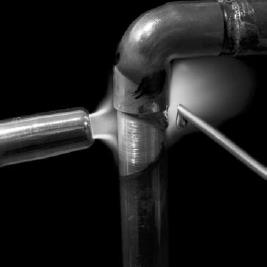Minerals, Metals, and Other MaterialsMan-Made Products |
What is solder? |
Solder is an alloy of two or more metals used for joining other metals together. One example of solder is half-and-half composed of equal parts of lead and tin. Other metals used in solder are aluminum, cadmium, zinc, nickel, gold, silver, palladium, bismuth, copper, and antimony. Various melting points to suit the work are obtained by varying the proportions of the metals.
Solder is an ancient joining method, mentioned in the Bible (Isaiah 41:7). There is evidence of its use in Mesopotamia some 5,000 years ago, and later in Egypt, Greece, and Rome. Use of numerous types of solder is currently wide and varied, and future use looks bright as well. As long as circuitry based on electrical and magnetic impulses and composed of a combination of conductors, semiconductors, and insulators continues to be in use solder will remain indispensable.
What is slag?
Slag is a non-metallic by-product of iron production that is drawn from the surface of pig iron in the blast furnace. Slag can also be produced in smelting copper, lead, and other metals. Slag from steel blast furnaces contains lime, iron oxide, and silica. The slag from copper and lead-smelting furnaces contains iron silicate and oxides of other metals in small amounts. Slag is used in cements, concrete, and roofing materials as well as ballast for roads and railways.

